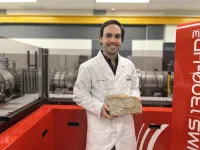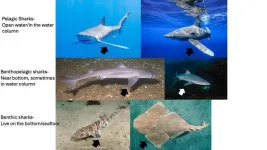(Press-News.org) Imagine you’re deep in the backcountry on a hiking trip, and you fall and rip a deep gash in your lower leg. You’re a two-day walk away from proper treatment. After you stop the bleeding, your concern becomes keeping the wound clean.
Now, imagine you had just the thing in your first aid kit—a spray-on bandage embedded with a mild painkiller and a disinfectant. A bandage meant to deliver relief, and degrade within 48 hours, giving you time to make it to the hospital.
That’s one reality that Whitney Blocher McTigue, an assistant professor of chemical and biomolecular engineering in Lehigh University’s P.C. Rossin College of Engineering and Applied Science, is working toward. She recently received a grant from the National Science Foundation to study the dynamics of how enzymes interact with polymer complexes and cause them to degrade.
“The inspiration for this research came from burn patients,” says Blocher McTigue. “People that suffer second- or third-degree burns are at high risk of infection, and so their wounds need to be cleaned regularly. However, when you remove traditional bandages, you actually remove a lot of the nascent healing that’s taken place. So every time you remove a bandage, you actually reduce and prolong the healing process.”
The ultimate goal, she says, is to develop a degradable bandage. But first, she and her team must better understand how the polymer complexes break apart. Polymer complexes comprise both negatively and positively charged peptides in either a liquid or solid state. The novelty of her lab’s approach, she says, is how they’re using enzymes to degrade the complexes.
“I like to think of enzymes like Pac-Man because they like to chew things up,” she says. “And they can do that faster or slower depending on the concentration of the enzyme.”
Once Blocher McTigue and her team better understand how the complexes and enzymes interact, they will be able to more effectively tune the structure of the complex itself—perhaps making it more positive or more negative—and the amount of enzyme required, based on the goal of the application. Essentially, they’ll be able to dictate how and when the degradation takes place.
For instance, a burn patient might require a bandage that breaks down, say, every four hours, in time for the next round of wound care. Or, medical providers might require a bandage that degrades in response to a specific stimulus—like a saline wash. Her team is also looking into how the technique could be used in drug delivery. Those sprayable bandages could be embedded with an analgesic, for instance, or a complex encapsulated with drugs or nutrients could be swallowed and timed to release its payload as it enters the small intestine.
“Or if you’re out in the field, or you’re a member of the military, and you experience some sort of physical trauma, a spray-on bandage could take the place of trying to pack a wound,” she says. “It would keep the wound relatively clean until you made it to the operating room where doctors could use saline to degrade the covering and then get to work.”
The potential applications are vast and exciting. But before the researchers can get to what Blocher McTigue calls “the really fun science,” they need to understand the dynamics of the interplay between polymer complex and enzyme.
“This grant is going to allow us to look at how we can fiddle with those dynamics and make them do exactly what we want them to do,” she says. “But I am very big into direct applications of research. Everyone in my lab is looking forward to how we can take this really cool fundamental science and, eventually, drop it into everyday use.”
About Whitney Blocher McTigue
Whitney Blocher McTigue is an assistant professor in the Department of Chemical and Biomolecular Engineering at Lehigh University.
She was previously a postdoctoral researcher in the chemical and biomolecular engineering department at the University of Illinois at Urbana-Champaign. She holds a PhD in chemical engineering with a certificate in soft materials for life sciences from the University of Massachusetts Amherst and a BS in chemical engineering from Clarkson University.
Blocher McTigue’s research focuses on using charged polymer species to solve real-world problems. The work from her PhD utilized complex coacervation, which is a liquid-liquid phase separation phenomenon, to encapsulate and thermally stabilize biomacromolecules.
Her resume includes an extensive list of publications, presentations, research proposals, honors, and teaching experiences. She won the best PhD dissertation award from the Department of Chemical Engineering at the University of Massachusetts Amherst in 2020 and her paper titled “Thermostabilization of Viruses via Complex Coacervation” was highlighted in the journal Biomaterials Science “Most Popular 2020.”
Related Links
Faculty Profile: Whitney Blocher McTigue
NSF Award Abstract (# 2347080): ERI: Degradation of Polyelectrolyte Complexes via Enzyme Addition END
Exploration of enzyme-polymer interactions is a crucial first step toward the development of next-gen degradable wound coverings
Research led by Lehigh University chemical and biomolecular engineering professor Whitney Blocher McTigue funded by NSF
2024-06-03
ELSE PRESS RELEASES FROM THIS DATE:
Pudukotai Dinakarrao receives funding for continuous and lightweight authentication for wearable and portable embedded systems
2024-06-03
Sai Manoj Pudukotai Dinakarrao, Assistant Professor, Electrical and Computer Engineering, received funding for the project: “CLAWS: Continuous and Lightweight Authentication for Wearable and Portable Embedded Systems.”
“The target of this funding is to accelerate the transition of technology,” Pudukotai Dinakarrao said.
Using this proposed authentication technique, Pudukotai Dinakarrao will collect the gait signal of a user continually using a lightweight always-on sensing methodology. The collected gait signal will be analyzed through resource-aware dynamic early-exit neural networks (EENets) for authentication.
The proposed technique ...
Most surface ozone contributing to premature mortality in European countries is imported
2024-06-03
Exposure to current levels of ground-level ozone (O3) in Europe is one of the main causes of premature mortality due to air pollution, especially in summer. A study led both by the Barcelona Institute for Global Health (ISGlobal), a centre supported by the "la Caixa" Foundation, in collaboration with the French National Institute of Health and Medical Research (Inserm), and the Barcelona Supercomputing Center - Centro Nacional de Supercomputación (BSC-CNS), has quantified for the first ...
The integration of clinical trials with the practice of medicine
2024-06-03
About The Study: This article discusses the need for better integration of clinical trials and health care delivery enterprises.
Corresponding Author: To contact the corresponding author, Derek C. Angus, M.D., M.P.H., email angusdc@pitt.edu.
To access the embargoed study: Visit our For The Media website at this link https://media.jamanetwork.com/
(doi:10.1001/jama.2024.4088)
Editor’s Note: Please see the article for additional information, including other authors, author contributions and affiliations, conflict ...
Fresh findings: Earliest evidence of life-bringing freshwater on Earth
2024-06-03
New Curtin-led research has found evidence that fresh water on Earth, which is essential for life, appeared about four billion years ago - five hundred million years earlier than previously thought.
Lead author Dr Hamed Gamaleldien, Adjunct Research Fellow in Curtin’s School of Earth and Planetary Sciences and an Assistant Professor at Khalifa University, UAE, said by analysing ancient crystals from the Jack Hills in Western Australia’s Mid West region, researchers have pushed back the timeline ...
Study finds people of color disproportionately dropped from Medicaid
2024-06-03
The COVID-19 pandemic dramatically improved health insurance coverage for millions of Americans who were automatically covered by Medicaid due to the national public health emergency.
With the end of the emergency in April 2023, about 10 million people lost coverage as states began redetermining eligibility. However, an estimated three-quarters of disenrollments occurred not because states decided they were ineligible, but rather due to procedural reasons. These process-related issues could include enrollees not receiving ...
Weight indices, cognition, and mental health from childhood to early adolescence
2024-06-03
About The Study: Lower cognitive performance and greater psychopathology at baseline were associated with increased weight gain as children entered adolescence, and higher baseline body mass index was associated with more depressive symptoms over time. These longitudinal findings highlight the importance of cognitive and mental health to children’s healthy weight development and suggest that clinicians should monitor children with overweight or obesity for increased depression problems.
Corresponding Author: To contact the corresponding author, Tamara Hershey, Ph.D., email tammy@wustl.edu.
To access the embargoed study: Visit our For The Media ...
Clinical outcomes after admission of patients with COVID-19 to skilled nursing facilities
2024-06-03
About The Study: The results of this cohort study suggest that admission of COVID-19–positive patients into skilled nursing facilities early in the pandemic was associated with preventable COVID-19 cases and mortality among residents, particularly in facilities with potential staff and personal protective equipment shortages. The findings speak to the importance of equipping skilled nursing facilities to adhere to infection-control best practices as they continue to face COVID-19 strains and other respiratory diseases.
Corresponding Author: To contact ...
Kinship and ancestry of the Celts in Baden-Württemberg, Germany
2024-06-03
The burial mounds of Eberdingen-Hochdorf and Asperg-Grafenbühl, known as Fürstengräber, are among the richest burials of German prehistory, with gold finds and elaborate bronze vessels. A new genetic analysis has now revealed that the two princes, buried about 10 kilometers apart, were biologically closely related. "It has long been suspected that the two princes from the burial mounds in Eberdingen-Hochdorf and Asperg ‘Grafenbühl‘ were related," says Dirk Krausse of the State Office for the ...
How sharks survived a major spike in Earth’s temperature
2024-06-03
The sharks we know today as the open ocean’s top predators evolved from stubby bottom dwellers during a dramatic episode of global warming millions of years ago.
A massive outpouring of volcanic lava about 93 million years ago sent carbon dioxide levels soaring, creating a greenhouse climate that pushed ocean temperatures to their hottest. UC Riverside researchers discovered that some sharks responded to the heat with elongated pectoral fins.
This discovery is documented in a paper published today in the journal Current Biology. It was made by taking body length and fin measurements from over 500 living and fossilized shark species.
“The ...
Cacao of Excellence announces the launch of the 2025 Edition of the Cacao of Excellence Awards
2024-06-03
[Rome, 3 June 2024] – Cacao of Excellence is delighted to announce the official launch of the 2025 Edition of the Cacao of Excellence Awards. Since its inception in 2009, Cacao of Excellence has been the premier platform for cacao producers to showcase the superior quality of their cacao, celebrating the diversity of flavours of cacao produced worldwide.
Held biennially, the Cacao of Excellence Awards bring together leading sensory evaluation experts and the chocolate industry to recognise and reward cacao producers who demonstrate excellence. The Awards offer the possibility for selected producers and the origins they represent to compete ...
LAST 30 PRESS RELEASES:
New modeling approach sheds light on rare gut disease
Study documents potentially hazardous flame retardants in firefighter gear
Can certain bacteria regulate aging of the immune system and its related alterations?
AI model helps diagnose often undetected heart disease from simple EKG
There are fewer online trolls than people think
Cell membrane fluctuations produce electricity
Jeonbuk National University study shows positive parenting can protect adolescents against self-harm
Surface-engineered ZnO nanocrystals to tackle perfluoroalkyl substance contamination
This new understanding of T cell receptors may improve cancer immunotherapies
A new fossil face sheds light on early migrations of ancient human ancestor
A new immunotherapy approach could work for many types of cancer
A new way to diagnose deadly lung infections and save lives
40 percent of MRI signals do not correspond to actual brain activity
How brain-inspired algorithms could drive down AI energy costs
Gum disease may be linked to plaque buildup in arteries, higher risk of major CVD events
Contrails are a major driver of aviation’s climate impact
Structure of dopamine-releasing neurons relates to the type of circuits they form for smell-processing
Reducing social isolation protects the brain in later life
Keeping the heart healthy increases longevity even after cancer
Young adults commonly mix cannabis with nicotine and tobacco
Comprehensive review illuminates tau protein's dual nature in brain health, disease, and emerging psychiatric connections
Book prepares K-12 leaders for the next public health crisis
Storms in the Southern Ocean mitigates global warming
Seals on the move: Research reveals key data for offshore development and international ecology
Sports injuries sustained during your period might be more severe
World's first successful 2 Tbit/s free-space optical communication using small optical terminals mountable on satellites and HAPS
Can intimate relationships affect your heart? New study says ‘yes’
Scalable and healable gradient textiles for multi‑scenario radiative cooling via bicomponent blow spinning
Research shows informed traders never let a good climate crisis go to waste
Intelligent XGBoost framework enhances asphalt pavement skid resistance assessment
[Press-News.org] Exploration of enzyme-polymer interactions is a crucial first step toward the development of next-gen degradable wound coveringsResearch led by Lehigh University chemical and biomolecular engineering professor Whitney Blocher McTigue funded by NSF




